Sequencing the Project Activities
Once the activities have been identified the next stage is to sequence them according to their dependencies. In other words, any relationships between activities need to be identified so that dependent activities can be scheduled to follow those that they are dependent upon.
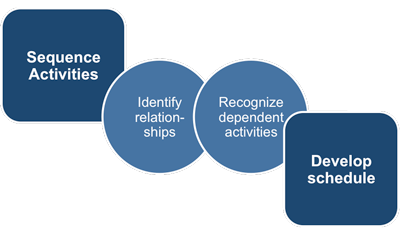 |
It is important to classify any dependencies properly because they indicate the sequence in which activities must occur. There are four types of dependency relationships.
A finish-to-start relationship exists if one activity must finish before another activity starts.
A start-to-start relationship exists if one activity cannot start until another activity starts.
A finish-to-finish relationship exists if the one activity cannot finish until another activity finishes.
A start-to-finish relationship exists if one activity must start before another can finish.
Dependencies may be external or internal. For example, an organization may subcontract the production of some deliverable from a supplier organization and the delivery of this would represent an external dependency, one that involves some relationship outside of the project and its control.
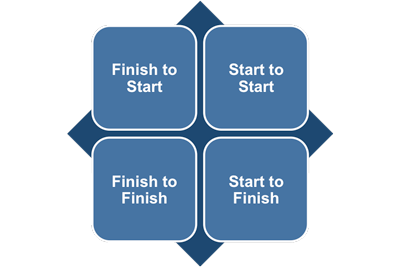 |
Some dependencies may exist within the project. For example, an engineer may only be able to contribute half of his time to a project, although his skills could potentially be used full time. You can check out the complete range of project management pdf eBooks free from this website.
The principal output from this process is a network diagram showing the sequence of activities and their relationships. Always bear in mind that the purpose of this process is simply to find and illustrate dependencies, there are assumed to be no resource constraints.
There are three interrelated techniques that can be used to sequence activities.
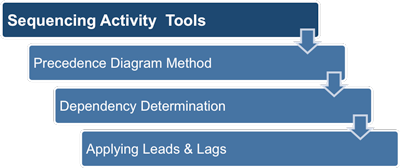 |
The precedence diagram is a graphical tool for scheduling activities in a project plan. It uses boxes or rectangles, referred to as nodes to represent activities and connects them with arrows to show the logical relationships that exist between them. This technique is also called Activity On Node (AON) and is the method used by most software project management packages.
 |
In this example,
• 'Begin' and 'End' are both milestones.
• Activities A and B are not dependent on each other.
• Activity C is dependent on both A and B (shown as a circle).
Many of the project planning software packages available use this method, which simply plots the tasks to be completed and connects them with arrows that show the dependencies. Note that each activity has an input arrow and an output arrow.
The only two elements that do not are the 'Begin' and 'End' milestones (which are not really activities). If an activity within a diagram has only one arrow then this is represents an error and needs to be corrected.
Three types of dependencies are used to define the sequence among the activities:
1) Mandatory
2) Discretionary
3) External
The table below shows the dependency and gives an explanation for this.
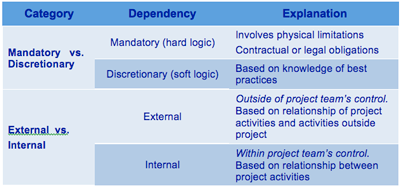 |
Mandatory dependencies are inherent in the work or process e.g. when constructing a new building, building the walls is dependent on laying the foundations. The project team determines which dependencies are mandatory to reach during the process of sequencing the activities. They are also sometimes referred to as hard logic.
Discretionary dependencies are those defined by the project manager and their team. They should be defined based on best practice or previous experience within the particular area. Discretionary dependencies are sometimes referred to as preferred logic and based on knowledge of best practices within a particular application area or some unusual aspect of the project where a specific sequence is desired even though there may be other acceptable sequences.
Discretionary dependencies should be fully documented since they can create arbitrary total float values and can limit later share dealing options.
 |
External dependencies involve a relationship between project activities and non-project activities. These dependencies are usually outside the project teams control. For example the testing activity in a software project can be dependent on the delivery of hardware from an external source.
Once the dependencies are agreed they can be mapped into a precedence diagram (on PC, on paper, or using post-it notes). When drawing the precedence diagram the project team needs to decide:
• Which tasks can only be completed after another task
• Which tasks can be done at the same time
• Which tasks don't depend on other tasks at all (e.g. project review meetings)
It can be useful to work backwards when compiling the precedence diagram and ask yourself what do we need to have done immediately before this task?
You will then need to apply leads and lags. A lag directs a delay in the successor activity. For example, an IT project requires two different but similar user interfaces to be designed, interfaces A and B. Each task is scheduled to take 5 days. There is no reason why these tasks cannot be started at the same time, but it makes sense to design A first and obtain user agreement before starting work on interface B which can then be largely based on A.
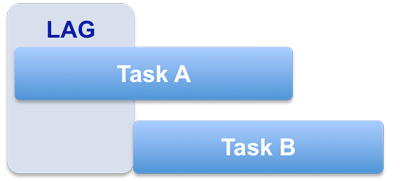 |
Therefore, the time between the start dates of the two tasks can be defined as a lag (The project manager has specified two days in this case). It is important to note that task B does not need to be completed before task A can begin but because some of the lessons learned in the design stage of task A can be directly applied to task B it will reduce the overall amount of work required if this lag is specified.
Lead refers to a relationship whereby the successor activity begins before the predecessor activity has completed. Lead is only found activities with finish-to-start relationships: A must finish before B can start. In order to leverage a lead, which will compress the total combined duration of both activities, the dependency must be discretionary, meaning that there is no physical limitation on completing A before B begins.
Standardized schedule network diagram templates can be used to expedite the preparation of networks of project activities. They can include an entire project or only a portion of it. Portions of a project schedule network diagram are often referred to as a sub-network or a fragment network.
Sub-network templates are especially useful when a project includes several identical or nearly identical deliverables, such as floors on a high-rise office building, clinical trials on a pharmaceutical research project, coding program modules on a software project, or the start-up phase of a development project.
These give rise to project schedule network diagrams, which are schematic displays of the project's schedule activities and the logical relationships among them, also referred to as dependencies.
 |
A project schedule network diagram can be produced manually or by using project management software. It can include full project details, or have one or more summary activities. A summary narrative can accompany the diagram and describe the basic approach used to sequence the activities. Any unusual activity sequences within the network should be fully described within the narrative.
You may also be interested in:
Managing the Project Schedule | Defining the Project Activities | Sequencing the Project Activities | Estimating the Resources Required | Estimating the Time Required | Developing the Project Schedule | Controlling the Project Schedule.
|
|


